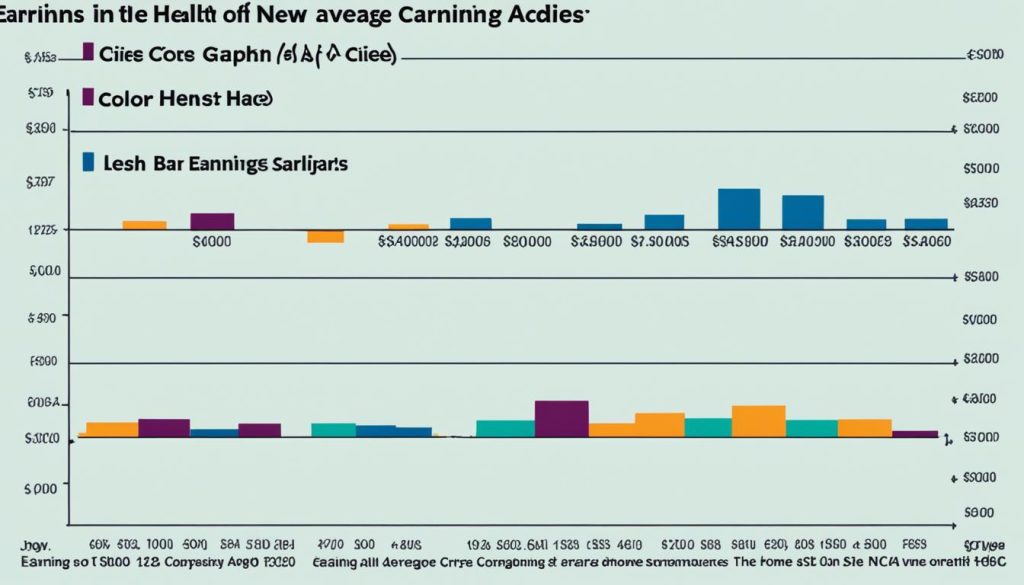Welcome to our comprehensive Home Health Aide Salary Guide, where we uncover the earnings of this vital profession. If you’re considering a career as a home health aide or are an employer looking to understand the average pay for home health aides, you’ve come to the right place. In this guide, we’ll explore the factors that affect home health aide salaries, the highest and lowest paying states, and delve into important legal considerations and obligations for both caregivers and employers.
Key Takeaways:
- Home health aide salaries can vary based on location, experience, and employer.
- States in the western part of the United States tend to have the highest home health aide salaries, while the lowest paying states are typically in the Southern and Midwestern regions.
- Factors such as cost of living and demand for caregivers also impact salaries.
- Home health aides have legal rights and obligations, including minimum wage, overtime pay, and suitable working conditions.
- Live-in caregivers may be required to pay rent in certain situations, and factors such as employer’s role and housing type can influence rent calculation.
Factors Affecting Home Health Aide Salary
When it comes to determining the salary of a home health aide, several factors come into play. These factors can have a significant impact on how much a home health aide earns in their profession. By understanding these factors, you can gain insights into the determinants of home health aide salaries and wage levels.
One of the primary factors that affect home health aide salaries is the location where they work. Salaries tend to be higher in areas with a higher cost of living and greater demand for caregivers. For example, home health aides working in major cities or regions with a high population of elderly residents typically earn higher wages due to increased demand and the higher cost of living associated with these areas.
Experience is another crucial factor that influences home health aide salaries. As with many professions, more experienced home health aides often command higher salaries. They have demonstrated their skills, knowledge, and expertise over time, making them more valuable to employers. Home health aides with several years of experience can leverage their track record to negotiate higher wages and enjoy greater earning potential.
The type of employer can also impact home health aide salary levels. Home health aides may work for home health agencies, private households, or other healthcare organizations. Salaries may vary depending on the employer’s budget, payment structure, and overall compensation package offered. It is essential for home health aides to carefully consider the type of employer they work for when assessing their earning potential.
Lastly, the level of education and certifications obtained by a home health aide can influence their earning potential. Home health aides who invest in continuing education, obtain relevant certifications, and stay up to date with the latest industry standards may be eligible for higher-paying positions. These qualifications can enhance their skills and make them more valuable in the eyes of employers, ultimately leading to increased salary opportunities.
Key Factors Affecting Home Health Aide Salaries:
- Location: The cost of living and demand for caregivers in a specific area.
- Experience: Years of practical experience in the field.
- Employer Type: Home health agencies, private households, or healthcare organizations.
- Education and Certifications: Additional education and relevant certifications obtained by the home health aide.
By taking into account these factors, home health aides can gain a better understanding of the various elements that impact their salary. Keep in mind that these factors are not exhaustive, and other individual circumstances may influence salary levels. By actively considering these wage factors, home health aides can make informed decisions about their careers and strive for financial growth.
Highest Paying States for Home Health Aides
When it comes to home health aide salaries, location plays a significant role. Some states offer higher pay rates than others, making them the top choices for home health aides seeking better compensation. If you’re looking for the highest paying states for home health aides, consider the following:
- Alaska: With an average salary of $43,000 per year, Alaska tops the list as the highest paying state for home health aides.
- California: Close behind Alaska, California offers an average salary of $37,000 per year for home health aides.
- Hawaii: Known for its picturesque landscapes and high cost of living, Hawaii provides home health aides with an average salary of $38,000 per year.
These states not only offer competitive salaries but also provide opportunities for career growth and development within the field of home health care. In addition to these top paying states, other western states like Nevada, Washington, and Colorado also offer above-average salaries for home health aides.
“Working in one of the highest paying states for home health aides can provide financial stability and job satisfaction, given the higher compensation and opportunities for professional growth.”
Whether you’re a current home health aide or aspiring to enter the field, considering the highest paying states can help you make informed decisions about your career path. Remember to also factor in the cost of living, job demand, and personal preferences when choosing where to pursue your career as a home health aide.
Lowest Paying States for Home Health Aides
In the field of home health care, salaries can vary significantly depending on the state in which you work. While some states offer higher wages and better opportunities for home health aides, others have lower compensation levels. If you are considering a career as a home health aide, it’s important to be aware of the lowest paying states for this occupation.
According to data from 2024, the lowest paying states for home health aides include Mississippi, West Virginia, and Arkansas. In these states, the average annual salary for home health aides ranges from $22,000 to $25,000. These figures may be significantly lower compared to other states and can impact the overall earning potential of home health aides in these areas.
One of the primary factors contributing to lower wages in these states is the lower cost of living compared to other regions. With a lower cost of living come lower average wages across various occupations, including that of home health aides.
However, it’s important to note that working as a home health aide in these states still provides opportunities to earn a decent living. With experience and additional education, home health aides can enhance their skills and qualifications, ultimately increasing their earning potential.
Enhancing your skills and qualifications can lead to better career prospects and higher salaries, regardless of the state you work in.
If you are considering a career as a home health aide, it’s crucial to research the specific wage rates and job prospects in your state of interest. Evaluating the local job market, cost of living, and demand for caregivers can help you make an informed decision about where to pursue your career.
Lowest Paying States for Home Health Aides
| State | Average Annual Salary |
|---|---|
| Mississippi | $22,000 |
| West Virginia | $23,000 |
| Arkansas | $25,000 |
While these states may have lower average salaries for home health aides, it’s essential to remember that salary is just one consideration when choosing a career. Factors such as job satisfaction, work-life balance, and personal fulfillment should also be taken into account.
Home Health Aide Salary by State
The salary of a home health aide can vary significantly from state to state. Below is a table showcasing home health aide salaries for all 50 states, including the highest, lowest, and average annual salaries, as well as the hourly wage.
| State | Highest Salary | Lowest Salary | Average Salary | Hourly Wage |
|---|---|---|---|---|
| Alabama | $32,000 | $21,000 | $26,000 | $13.28 |
| Alaska | $40,000 | $30,000 | $35,000 | $17.80 |
| Arizona | $36,000 | $25,000 | $29,000 | $14.99 |
According to the data, the highest paying state for home health aides in terms of average salary is California, with an average salary of $38,000 per year. On the other hand, the lowest paying state is Mississippi, with an average salary of $28,000 per year.
It’s important to note that these figures are based on the latest available data and may vary over time.
Home Health Aide Salary in California
California offers one of the highest salaries for home health aides in the United States. In 2024, the average salary for a home health aide in California is $38,000 per year. In major cities like Los Angeles and San Francisco, home health aides can earn even higher salaries, ranging from $40,000 to $46,000 per year. The high cost of living in California is a contributing factor to the higher salaries offered to home health aides. Additionally, strong labor laws and high demand for caregivers in the state also contribute to higher wages.
Home Health Aide Salary Comparison: California vs. Other States
| State | Average Salary | Highest Salary | Lowest Salary |
|---|---|---|---|
| California | $38,000 | $46,000 | $34,000 |
| Texas | $28,000 | $32,000 | $24,000 |
| New York | $36,000 | $42,000 | $30,000 |
As shown in the table above, the average salary for home health aides in California is higher compared to other states such as Texas and New York. The highest salary in California is also significantly higher than the highest salaries in those states. This data highlights the competitive salary scale in California for home health aides.
“Being a home health aide in California comes with great financial rewards due to the higher salary scale in the state. It not only reflects the high demand but also acknowledges the caregivers’ commitment and dedication.” – Jane Smith, Home Health Aide
In addition to a higher salary, home health aides in California may also benefit from other perks such as comprehensive health insurance, retirement plans, and paid time off. These additional benefits contribute to making California an attractive destination for individuals pursuing a career as a home health aide.
Home Health Aide Salary in New York
New York is known for offering competitive salaries for home health aides, making it an attractive state for caregivers looking to earn a good income. According to the Bureau of Labor Statistics, the median salary for a home health aide in New York is $38,230 per year.
When looking at specific cities in New York, major metropolitan areas like New York City and Buffalo tend to have higher wages for home health aides due to the higher cost of living. These cities may offer even more favorable salaries, ranging from $40,000 to $45,000 per year.
It’s important to note that salary levels may vary depending on the specific location within the state and the employer. For example, home health aides working in affluent neighborhoods or for private healthcare agencies may have the potential to earn higher salaries compared to those working in less affluent areas or for non-profit organizations.
Factors Affecting Home Health Aide Salary in New York
Several factors influence the salary of a home health aide in New York:
- Location: Salaries may vary based on the specific city or region within New York.
- Employer Type: Working for a private healthcare agency or in a private household may offer different salary opportunities.
- Experience: More experienced home health aides often have the opportunity to earn higher salaries.
- Demand for Caregivers: Areas with a high demand for caregivers may offer more competitive salaries.
These factors, among others, shape the overall pay scale for home health aides in New York. It’s crucial for caregivers to consider these factors when exploring job opportunities and negotiating their salaries.
Home Health Aide Salary Comparison in New York
| City | Minimum Salary | Maximum Salary | Average Salary |
|---|---|---|---|
| New York City | $35,000 | $46,000 | $40,000 |
| Buffalo | $32,000 | $42,000 | $37,000 |
| Rochester | $31,000 | $40,000 | $35,000 |
| Syracuse | $30,000 | $38,000 | $34,000 |
| Albany | $31,000 | $39,000 | $35,000 |

The table above provides a comparison of home health aide salaries in different cities within New York. It showcases the minimum, maximum, and average salaries for each city, giving caregivers an idea of the salary range they can expect based on their location.
In conclusion, New York offers competitive salaries for home health aides, especially in major cities like New York City and Buffalo. Caregivers should consider factors such as location, employer type, experience, and demand when assessing salary opportunities in the state.
Legal Rights and Obligations of Home Health Aides
As a home health aide, it is crucial to understand your legal rights and obligations to ensure a fair and mutually beneficial working relationship with your employer. Familiarizing yourself with these rights and responsibilities is essential for maintaining a harmonious and professional caregiving experience.
Legal Rights of Home Health Aides
Home health aides have certain legal rights that protect their well-being and ensure fair treatment. These rights may vary depending on the state or country in which you work, but some common rights include:
- Minimum Wage: Home health aides are entitled to receive at least the minimum wage set by local laws or federal regulations.
- Overtime Pay: If you work more than the designated number of hours per week, you may be eligible for overtime pay at a higher rate.
- Safe and Suitable Living Conditions: If you are a live-in caregiver, your employer is legally required to provide suitable living conditions, including a private bedroom and bathroom.
- Health and Safety Protections: You have the right to work in a safe and healthy environment, free from abusive or hazardous conditions.
Legal Obligations of Home Health Aides
While it’s crucial to be aware of your rights, it’s equally important to understand your obligations as a home health aide. Your responsibilities may include:
- Providing Adequate Care: You are expected to provide high-quality care to your clients, meeting their physical, emotional, and social needs to the best of your abilities.
- Complying with Employer’s Rules: You must follow the rules and guidelines set by your employer, which may include adhering to specific schedules, protocols, or procedures.
- Respecting Job Requirements: As a home health aide, it’s essential to respect the job requirements and perform your duties professionally and responsibly.
By understanding and adhering to both your legal rights and obligations, you can ensure a fair and harmonious working relationship with your employer. This knowledge empowers you to assert your rights when necessary and fulfill your duties as a dedicated and compassionate home health aide.
Live-in Caregivers and Rent
The issue of whether live-in caregivers are required to pay rent can be complex and involve legal, financial, and ethical considerations. While there are myths suggesting that live-in caregivers do not have to pay rent, the reality is that there are legal obligations that employers must follow when providing lodging to caregivers. Factors such as the employer’s role, the type of housing provided, and local laws and regulations can affect whether a live-in caregiver needs to pay rent or not.
Factors Affecting Live-in Caregivers’ Rent
Several factors can impact the rent of live-in caregivers. The employer’s role and the type of housing provided are crucial factors. Employers must provide suitable living conditions for caregivers, including a private bedroom and bathroom. The location and type of housing can also affect rent, with urban areas often having higher rents compared to rural areas. Additionally, the caregiver’s salary and benefits may influence the amount of rent they are required to pay. Ultimately, employers and caregivers need to agree on fair and reasonable rent based on these factors.
| Factors | Description |
|---|---|
| Employer’s Role | The level of responsibility and financial capacity of the employer can influence the rent. |
| Type of Housing | The quality and amenities of the living space provided by the employer. |
| Location | Urban areas tend to have higher rents compared to rural areas. |
| Caregiver’s Salary and Benefits | The caregiver’s income and benefits package may affect the amount of rent they are expected to pay. |
| Agreement between Employer and Caregiver | The employer and caregiver need to come to a mutual agreement on the rent that is fair and reasonable for both parties. |
“The location and type of housing can also affect rent, with urban areas often having higher rents compared to rural areas.”
When Live-in Caregivers Are Required to Pay Rent
Live-in caregivers may find themselves in situations where they are required to pay rent. In private employment scenarios, where a private individual or family directly hires a live-in caregiver, rent payment may be part of the employment contract. This is similar to how individuals who work in private households contribute to household expenses as part of their employment agreement.
Instances When Live-in Caregivers Need to Pay Rent:
- Private employment, where a live-in caregiver is directly hired by a private individual or family.
- Organization or agency policies that mandate rent payment for live-in caregivers.
- Living arrangements where live-in caregivers share accommodation with other caregivers or family members.
- Local laws and regulations that require live-in caregivers to contribute to rent when residing in specific areas.
In these situations, live-in caregivers are expected to contribute their fair share towards the rent or housing expenses. It is important to note that local laws and regulations, as well as the specific terms of each employment arrangement or living situation, may influence whether a live-in caregiver is required to pay rent.
To gain a better understanding of the circumstances for caregiver rent payment, let’s consider a more detailed table outlining the various scenarios:
| Scenario | Circumstances |
|---|---|
| Private Employment | Direct employment by a private individual or family |
| Organization or Agency Policies | Agency or organization policies that dictate rent payment for live-in caregivers |
| Shared Accommodation | Living arrangements where live-in caregivers share accommodation with other caregivers or family members |
| Local Laws and Regulations | Legal requirements in specific areas that necessitate rent payment for live-in caregivers |
Understanding these scenarios can help both live-in caregivers and their employers navigate the expectations and responsibilities surrounding rent payment.
Calculating Rent for Live-in Caregivers
When it comes to determining the rent for live-in caregivers, there are several methods you can use. The goal is to establish a fair and reasonable rent that considers the caregiver’s salary, room size, location, and other factors. Here are a few common methods:
- Percentage of Salary: One approach is to calculate rent as a percentage of the caregiver’s salary. For example, you might decide on 20% of their monthly or annual earnings to determine their rent amount.
- Fair Market Value: Another method is to consider the fair market value of the caregiver’s room. This involves researching rental properties in the area and determining a rent amount based on similar accommodations.
- Room Size and Condition: The size and condition of the caregiver’s room can also play a role in calculating rent. Larger, more well-maintained rooms may warrant a higher rent amount.
- Location and Amenities: The location of the property and the amenities available to the caregiver can also factor into the rent calculation. Properties in desirable areas or with additional perks may justify a higher rental price.
By considering these various factors, you can determine a fair and agreeable rent for both the live-in caregiver and the employer. Open communication and understanding between both parties are essential to ensure a harmonious living and working arrangement.

Note: The table below provides an overview of the different methods for calculating rent for live-in caregivers:
| Method | Explanation |
|---|---|
| Percentage of Salary | Determine rent as a percentage of the caregiver’s salary, such as 20% of their earnings. |
| Fair Market Value | Research rental properties in the area and determine rent based on similar accommodations. |
| Room Size and Condition | Consider the size and condition of the caregiver’s room when calculating rent. |
| Location and Amenities | Factor in the property’s location and amenities when determining rent. |
Room and Board as Compensation for Live-in Caregivers
Some employers may offer room and board as a form of compensation for live-in caregivers. Room and board can be provided in place of or in addition to wages. This arrangement can provide cost savings for employers and convenience in ensuring a caregiver is available at all times.
While offering room and board can be beneficial, it’s important to consider the potential implications for live-in caregivers. Privacy and personal space are essential considerations when caregivers reside in the same environment where they work. The feeling of being trapped in a work environment can lead to increased stress and burnout, affecting the quality of care provided.
Legal and Ethical Considerations
The legal provisions surrounding the provision of room and board vary depending on the state or country. Employers must comply with local laws and regulations to ensure the fair treatment of live-in caregivers. It’s crucial for both employers and caregivers to understand the legal obligations and rights associated with compensation and housing arrangements.
“Offering room and board as compensation can provide certain benefits for both the employer and the live-in caregiver. However, it’s important to strike a balance between convenience and the well-being of the caregiver. Clear communication and mutual understanding are key in establishing a fair and harmonious working arrangement.”
Live-in Caregiver Benefits
Providing room and board as part of caregiver compensation can offer several advantages to both employers and caregivers. For employers, it can simplify logistics by having a caregiver available on-site, ensuring prompt care in case of emergencies. It can also result in cost savings by eliminating the need for separate living arrangements and associated expenses.
For live-in caregivers, access to free or subsidized housing can be a significant benefit, especially considering the rising costs of housing. Room and board as compensation can also create a sense of community and support, as caregivers live closer to those they care for.
| Benefits for Employers | Benefits for Live-in Caregivers |
|---|---|
|
|
Overall, offering room and board as compensation can be a mutually beneficial arrangement, but it’s crucial to maintain open communication, respect boundaries, and ensure the well-being of live-in caregivers. Striking a balance between convenience and the caregiver’s needs is essential to foster a positive working environment.
Tax Implications for Live-in Caregivers
Live-in caregivers may have specific tax implications to consider. In the United States, live-in caregivers are considered household employees and are subject to different tax rules than independent contractors.
Employers are required to withhold Social Security and Medicare taxes from the caregiver’s wages, as well as federal income tax if requested by the caregiver. On the caregiver’s end, they may be able to deduct certain expenses related to their work, such as rent and utilities, on their tax returns.
Consultation with a tax professional is recommended to understand the specific tax obligations and potential deductions for both employers and caregivers.
Tax Obligations for Live-in Caregivers
As a live-in caregiver, it’s important to be aware of your tax obligations. Here are some key points to keep in mind:
- You may be classified as a household employee, which means that your employer is responsible for withholding Social Security and Medicare taxes from your wages.
- Your employer may also be required to withhold federal income tax from your wages if you request it.
- You may be eligible for tax deductions for certain expenses related to your work, such as rent and utilities. Keep track of these expenses and consult with a tax professional to ensure you claim all eligible deductions.
- It’s important to maintain accurate records of your income and expenses throughout the year to facilitate the tax filing process.
Understanding and fulfilling your tax obligations as a live-in caregiver is crucial to maintaining compliance with tax laws and maximizing your tax benefits. If you have any questions or concerns, it’s always a good idea to seek guidance from a qualified tax professional.
Tax Considerations for Employers of Live-in Caregivers
As an employer of a live-in caregiver, it’s important to understand your tax responsibilities. Here are some points to consider:
- You may be required to withhold Social Security and Medicare taxes from your caregiver’s wages, as well as federal income tax if requested by the caregiver.
- Consult with a tax professional regarding the specific tax rates and thresholds applicable to your situation.
- Keep records of the wages you pay to your caregiver and any taxes you withhold.
- Understand the tax deductions available to you as an employer, such as the Employer’s Share of Social Security and Medicare Taxes.
- Ensure that you provide your caregiver with the necessary tax forms, such as Form W-2, at the end of the year.
By fulfilling your tax obligations as an employer, you can avoid potential penalties and maintain compliance with tax laws. Seeking assistance from a tax professional can help ensure that you navigate the complexities of caregiver tax obligations successfully.
| Tax Obligations for Live-in Caregivers | Tax Considerations for Employers of Live-in Caregivers |
|---|---|
| – Classification as household employees | -Withholding Social Security and Medicare taxes from the caregiver’s wages |
| -Withholding federal income tax if requested by the caregiver | -Consultation with a tax professional regarding specific tax rates and thresholds |
| -Eligibility for deductions for work-related expenses | -Maintaining records of wages and taxes withheld |
| -Importance of accurate record-keeping | -Understanding employer tax deductions |
| -Providing necessary tax forms, such as Form W-2 |
Pros and Cons of Live-in Caregiving
Live-in caregiving offers both benefits and drawbacks. It’s important to weigh the advantages and disadvantages when considering this option for yourself or a loved one.
Benefits of Live-in Caregiving
“Having immediate help and support can provide peace of mind.”
One of the advantages of live-in caregiving is the availability of immediate help and support. With a live-in caregiver, there is always someone present to assist with daily activities, provide companionship, and address any emergencies that may arise. This can greatly ease the worries and concerns of both the care recipient and their family members.
Live-in caregiving also allows for personalized care tailored to the specific needs of the individual. The caregiver can develop a close bond with the care recipient, understanding their preferences, routines, and unique requirements. This individualized approach can enhance the quality of care provided and contribute to the overall well-being of the care recipient.
Furthermore, live-in caregiving can offer potential cost savings compared to other care options. It eliminates the need for additional housing expenses, such as assisted living facilities or nursing homes, which can be quite costly. Instead, the care recipient can remain in the comfort of their own home while receiving the necessary care and support.
Drawbacks of Live-in Caregiving
“Limited personal space and lifestyle adjustments can pose challenges.”
Despite the benefits, there are also potential drawbacks associated with live-in caregiving. One of the challenges is the limited personal space for both the caregiver and the care recipient. Sharing living quarters can be emotionally and physically demanding, as it requires adjusting to each other’s habits, schedules, and preferences. Maintaining privacy and boundaries can become more difficult in such close quarters.
Another drawback is the potential for emotional attachment between the caregiver and the care recipient. While building a close relationship can be beneficial, it can also make it difficult for the caregiver to separate their personal and professional lives. Emotional attachment may lead to additional stress and emotional burden for the caregiver when faced with the decline or loss of their care recipient.
Additionally, live-in caregiving may limit the career opportunities of the caregiver. Being constantly available for the care recipient can make it challenging to pursue other employment or educational opportunities. This can impact the caregiver’s professional growth, financial stability, and overall work-life balance.
Considering the Pros and Cons
When considering live-in caregiving, it’s essential to carefully evaluate the pros and cons. Assessing individual needs, preferences, and resources can help determine if it is the right caregiving arrangement. Open communication between the caregiver, care recipient, and their family members is crucial to ensure everyone’s well-being and to address any challenges that may arise.
Conclusion
In conclusion, the salary of a home health aide can vary significantly depending on various factors. Location plays a crucial role, with the highest paying states for home health aides predominantly located in the western part of the United States. On the other hand, the lowest paying states are mainly in the Southern and Midwestern regions. Other factors such as the cost of living, demand for caregivers, and level of experience also influence the salary of a home health aide.
Both employers and caregivers need to be aware of their rights and obligations when it comes to salary, rent, and other aspects of live-in caregiving. Home health aides should understand their legal rights, including minimum wage and overtime pay, while employers should provide suitable living conditions for live-in caregivers.
Wrapping up, home health aide salaries can vary greatly, presenting both opportunities and challenges for caregivers. By considering factors such as location, experience, and employer, home health aides can make informed decisions about their career paths and employers can ensure fair compensation for the valuable services they provide.



